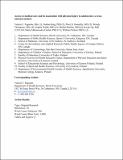Access to medical care and its association with physical injury in adolescents : a cross-national analysis
Abstract
Background Strong variations in injury rates have been documented cross-nationally. Historically, these have been attributed to contextual determinants, both social and physical. We explored an alternative, yet understudied, explanation for variations in adolescent injury reporting-that varying access to medical care is, in part, responsible for cross-national differences. Methods Age-specific and gender-specific rates of medically treated injury (any, serious, by type) were estimated by country using the 2013/2014 Health Behaviour in School-aged Children study (n=209 223). Available indicators of access to medical care included: (1) the Healthcare Access and Quality Index (HAQ; 39 countries); (2) the Universal Health Service Coverage Index (UHC; 37 countries) and (3) hospitals per 100 000 (30 countries) then physicians per 100 000 (36 countries). Ecological analyses were used to relate injury rates and indicators of access to medical care, and the proportion of between-country variation in reported injuries attributable to each indicator. Results Adolescent injury risks were substantial and varied by country and sociodemographically. There was little correlation observed between national level injury rates and the HAQ and UHC indices, but modest associations between serious injury and physicians and hospitals per 100 000. Individual indicators explained up to 9.1% of the total intercountry variation in medically treated injuries and 24.6% of the variation in serious injuries. Conclusions Cross-national variations in reported adolescent serious injury may, in part, be attributable to national differences in access to healthcare services. Interpretation of cross-national patterns of injury and their potential aetiology should therefore consider access to medical care as a plausible explanation.
Citation
Pagnotta , V F , King , N , Donnelly , P D , Thompson , W , Walsh , S D , Molcho , M , Ng , K , Malinowska-Cieslik , M & Pickett , W 2023 , ' Access to medical care and its association with physical injury in adolescents : a cross-national analysis ' , Injury Prevention , vol. 29 , no. 1 , pp. 42-49 . https://doi.org/10.1136/ip-2022-044701
Publication
Injury Prevention
Status
Peer reviewed
ISSN
1353-8047Type
Journal article
Description
Funding: Grant funding for this analysis was provided by the: (1) Centre for Surveillance and Research, Public Health Agency of Canada (6D016-123071/001/SS); 2) Canadian Institutes of Health Research (Project Grant PJT 162237); 3) Polish National Science Centre (2013/09/B/HS6/03438). Corresponding author, Valerie F. Pagnotta, is supported by a CIHR Frederick Banting and Charles Best Canada Graduate Scholarship.Collections
Items in the St Andrews Research Repository are protected by copyright, with all rights reserved, unless otherwise indicated.

